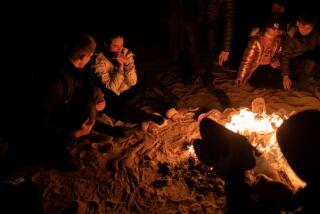Fighting Afghan information war
The accusation was damning: U.S. soldiers were said to have tossed a grenade into a crowd of Afghans in the eastern province of Kunar on Tuesday, killing two civilians and wounding five to 50 others.
American public affairs officers previously have been slow in responding. U.S. military officials here complain that Taliban leaders are often better and faster at spreading their versions of deadly events.
This time, however, public affairs officers mounted a swift and detailed information operation. Within 24 hours, a public affairs team at Bagram air base released a video showing an explosion as U.S. soldiers worked to free an American military vehicle stuck on a median in the town of Asadabad. It also provided technical details it said proved the grenade was a Russian-made version commonly used by insurgents.
It is not clear from the murky video, taken at a distance, who threw the grenade. But no American soldier is seen throwing anything.
The unusually rapid release of the video was clearly intended to show that American soldiers working on a marooned vehicle were hardly likely to detonate a grenade next to their own vehicles and comrades, three of whom were slightly wounded.
The video was posted on Facebook and YouTube, part of a burgeoning U.S. effort to use social networking sites to build support for coalition forces locked in a struggle to win over the Afghan population in the face of an entrenched Islamic insurgency. The U.S. military regularly issues statements denying accusations of misconduct, but release of combat videos has been rare.
The overnight posting of the video underscores the long-held belief within the U.S. military that it needs to be faster and more sophisticated in responding to false allegations.
Army Lt. Col. Clarence Counts, a public affairs officer at Bagram, said officials sped up the normally cumbersome release process for sensitive video feeds to quickly knock down the grenade accusations. Counts said he could not recall a similar instance in recent months.
Counts, who was involved in the information effort over the grenade accusations, said officers decided “to be a little quicker off our feet” once they realized the video was available.
“We’d love to be able to do this every time,” he said. “That’s our goal.”
Counts said U.S. officials understood that they needed to improve their information efforts, but often were constrained by security regulations that keep sensitive information under wraps. Taliban militants release detailed statements almost instantly because they often make up the information, Counts said.
An improved flow of information is seen as a crucial priority for Army Gen. Stanley McChrystal, the incoming commander of U.S. and allied forces in Afghanistan, as he overhauls the Afghan war strategy.
Further underscoring the importance, the military has appointed a Navy rear admiral, Greg Smith, to oversee public affairs operations in Afghanistan. McChrystal is said to want more rapid public disclosure of information.
Recently, U.S. commanders here have expressed frustration over the propaganda bonanza provided to insurgents by the deaths of civilians in numerous U.S. airstrikes over the years.
“We’re the superior fighting force, but they [the Taliban] find our weaknesses and go for them,” said Air Force Lt. Col. Keith Bryza, who helps plan air support for ground units but is not involved in information efforts. “The Taliban is very good” at information operations.
In incidents of civilian deaths, American officers have accused Taliban fighters of firing from civilian areas and using civilians as human shields. They have also said that the numbers of casualties have been exaggerated. But the U.S. rarely releases video from unmanned aircraft or satellites to bolster its case.
In the grenade incident, an Afghan Education Ministry statement released Tuesday accused U.S. soldiers of throwing a “hand bomb” that “martyred” at least one civilian. Several residents also told reporters that they had seen an American soldier toss or launch a grenade.
The U.S. military initially responded Tuesday as it usually does in such incidents, with a bland statement denying any role in the explosion.
But on Wednesday, public affairs officers followed up with the video, along with detailed illustrations of a Russian grenade. An accompanying statement pointed out that insurgents had used Russian grenades to attack coalition forces.
“This video directly disputes the claims by Umranullah, a local shopkeeper, and Asadullah Roya, an education official, who reported the U.S. service members had thrown the grenade,” the statement said.
The military said the grenade was thrown from a nearby building.
Afghan President Hamid Karzai, who has complained bitterly about civilian deaths caused by American airstrikes, did not entirely absolve U.S. soldiers of complicity in the grenade incident. Instead, he chided coalition forces.
“Stressing the need to protect the lives and property of civilians, President Karzai once again reminded the international forces to make every effort to avoid incidents that lead to civilian casualties,” Karzai’s office said in a statement.
Karzai, facing an election in August and eager to win over voters, ordered an investigation.
The U.S. military said the video was taken by a stationary balloon equipped with a camera. Such balloons are anchored at or near many coalition forward operating bases.
The military has been reluctant to release videos of combat operations, saying that such action could expose combat tactics or surveillance and intelligence-gathering methods.
Unmanned aircraft watch over U.S. convoys and combat units for hours at a time. Cameras on the drones take close-up video, day and night, that captures firefights, airstrikes and attacks on convoys and U.S. ground units.
But for security reasons, such video is rarely released, even in disputed incidents involving disturbing allegations against coalition forces.
--
Times staff writer Julian E. Barnes in Washington contributed to this report.
More to Read
Start your day right
Sign up for Essential California for news, features and recommendations from the L.A. Times and beyond in your inbox six days a week.
You may occasionally receive promotional content from the Los Angeles Times.







